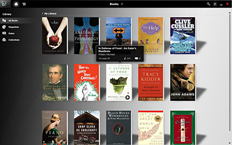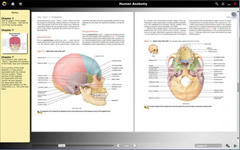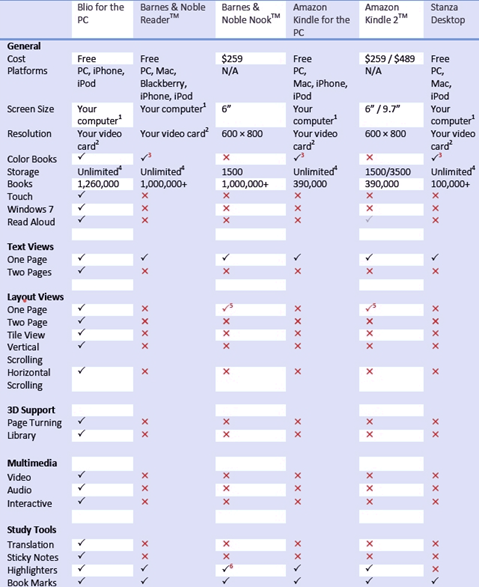 The Blio reading app, old news to TeleRead community members, will be in the spotlight at CES. Wired News has an upbeat story quoting the legendary Ray Kurzweil, one of the developers: “We have high-quality graphics and animated features. Other e-readers are very primitive.”
The Blio reading app, old news to TeleRead community members, will be in the spotlight at CES. Wired News has an upbeat story quoting the legendary Ray Kurzweil, one of the developers: “We have high-quality graphics and animated features. Other e-readers are very primitive.”
As he sees it, people will want to read e-books on multiuse devices that can display color—like, er, that the tablet that Apple-ologists are all atwitter about—which the current E Ink machines can’t do.
“We can take a PDF and an audio book and merge the two to get a combination such that you can hear the audio book and see the words highlighted on the PDF at the same time,” Peter Chapman, a Kurzweil Technologies exec, is quoted. Blio, furthermore, will apparently run on of platforms including tablets and desktop PCs.
Fine by me. The question I’m curious about is what Blio could mean in the book-related format wars. Past talk has it that Blio will be handle ePub among other formats. I’d hope so, especially since the National Federation of the Blind has also played a role in its development, via a joint venture, knfb Reading Technology; and ePub is catnip for accessibility advocates. I just hope that Blio is not going to play up its own format. Unfortunately it apparently will.
 Significantly, the Wired piece says that “Blio preserves the original book’s format, including typsetting, layout, fonts and pagination.” Is that in the spirit of ePub, which emphasizes reflowability, so books can be comfortably read on screens with a variety of sizes and aspect ratios? Granted, you can lock up ePub so it is PDFish. But mightn’t that defeat a major purpose of it? Meanwhile Gizmodo and Ubergizmo talk about, yes, a separate e-book format. So despite Blio’s ePub capability, more eBabel appears to be on the way.
Significantly, the Wired piece says that “Blio preserves the original book’s format, including typsetting, layout, fonts and pagination.” Is that in the spirit of ePub, which emphasizes reflowability, so books can be comfortably read on screens with a variety of sizes and aspect ratios? Granted, you can lock up ePub so it is PDFish. But mightn’t that defeat a major purpose of it? Meanwhile Gizmodo and Ubergizmo talk about, yes, a separate e-book format. So despite Blio’s ePub capability, more eBabel appears to be on the way.
In a related vein, Nate at MR says that at CES Blio will be sharing a Microsoft booth. Is that a sign that Microsoft is indeed getting seriously back into e-books, and if so, could Blio be a Trojan Horse, as a new Microsoft-blessed format?
Like others, I’ll also be curious about Blio in another respect—whether it could provide a boost for digitized magazines and newspapers.
Related: A placeholder for a Blio Web site that Nate ran across. I checked and, yes, the site is registered in the name of K-NFB. The second image is from the Gizmodo article on Blio. Meanwhile, ahead, I’ll repro a chart from the Blio people, comparing their baby with rivals.



































Personally I have to wonder what Blio means for Sophie.
— C
I’m a bit confused about that chart. I use the Barnes and Noble eReader software on Windows 7 and have two page view. Also the iPhone version at least has auto scrolling, to be honest I haven’t looked on Mac or PC to see if that is true.
I’m more concerned with YET ANOTHER eBook format. I’ve thrown my money into nook (and set aside my Kindle 2 for now) because of it’s ePub support, screen and price. ePub means I can buy DRM and non-DRM books from many retailers, preserving choice and competition. Regarding price and screen – I enjoy the 3G features, since I like to buy books while I browse in a B&N or Borders store. The Sony Daily Edition is $140 more and I don’t like the touch screen. The nook is the best looking screen I’ve seen in a mainstream reader.
Maybe Blio is MSReader 3.0. 😉
And we all know the story with version 3 apps at microsoft.
I’m welcoming this; eBabel be, er, darned, its early in the game and I welcome an open alternative to Adobe’s monoculture hijacked epub and Kindle.
All this “excitement” over what? Just another computer/computer application and another nail in the coffin of reading being fundamental to success and civilization. Seems to me that the extreme religious right will only have to wait a decade or two to have its work done for it by people whose only goal is to have a single device that can do it all, which will mean that anything that requires work, which reading does, will fall by the wayside, thus taking us back to the days of ignorance being bliss.
I guess I’m an old stuck-in-the-mud fuddy-duddy who thinks that reading is a worthwhile, important, necessary, civilizing, democratizing, educational endeavor all by its lonesome — without the ability to avoid it by watching a video or twittering.
I know and have loudly heard the arguments regarding convenience, the need to invest in a single device, and the like; what I haven’t heard raised and discussed is what effect multiuse devices will (and do) have on the fundamental of reading. Video literacy doesn’t strike me as good foundation for keeping progress going.
LOL. Perhaps Kurzweiler subcontracted the whole job to Microsoft. At any rate, I agree with Scott Lewis. The last thing we need is another e-book format to distract publishers and reduce human readers’ choices. Especially I want files to be reflowable as opposed to designed for specific devices, and I wonder about Blio in that regard.
Interestingly, the NYT has done some great work on its reader, which has a highly polished look and yet can adjust to a variety of machines.
Thanks,
David
Yep the chart is definitely slanted pretty heavily, and just outright wrong in several cases.
As already mentioned B&N Reader offers a two-up view, and I’m also still trying to figure out why you would want a two-up view on a 6″ eInk device.
Also, I’m pretty sure the Nook offers pan & scan on PDF files, but you only really need “horizontal scrolling” on non-reflowable formats, which they seem to totally discount the use of.
In fact at a file format level they seem to be going after the PDF a lot more than they are going after ePub. So it occurs to me that they are (deliberately or not) doing an apples to Orange comparison, especially when they didn’t add Adobe Reader or Acrobat into the comparison chart…
The Blio reminds me of the Internet Archive’s way of presenting a ‘book’ too, right down to the faux turning of the pages, preservation of layout, etc. IA won’t read along with the book, though, and for young readers (and second-language learners) the feature of highlighting the text words as they are spoken is a nice idea.
We’ll have to wait for more details, but to me, this doesn’t look like a new format, per se, so much as a program that can present already-existing formats such as PDF in a new way.
Also we can file this in the backward-looking approach to etexts, where we lump together all those attempts to recreate the ‘look and feel’ of a ‘real book’ on a screen. It’s interesting that so many of these backlooks slow down the process of getting us to the next page/screen as though it were a virtue — but we all gnash our teeth and complain about the slow page refresh of current eink screens!
I think it looks great for color content like magazines and comic books, but has little appeal for something text heavy like a novel. Most of the product features listed in the chart are things most readers, the people not the device, have no or little interest. Plus further fracturing the market will cause market confusion and delay adoption. Yet, as there is currently no “e-comic book” format, it could lead to digital distribution for comics.
@Jim Lester:
The Hanlin V3 ebook readers (sold as Astak, BeBook, Papyre, Lbook, etc) have the capability to do two-page landscape for non-Adobe formats. And, it actually works out nicely if you favor smaller font sizes.
(Which I do.)
I was pleasantly surprised at how much like a paperback it felt…
The enabling app (Coolreader 3.x) is well-regarded and coming to several other ebook readers in the near term so more readers will be able to brag of two-up displays.